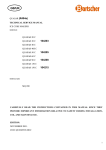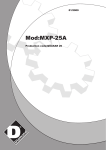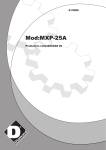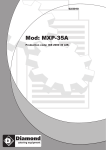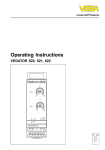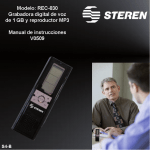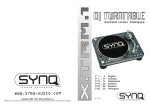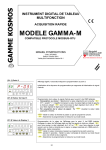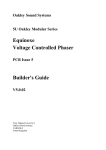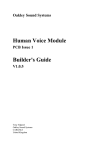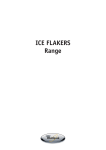Download Installation Manual of WHIRLPOOL ADN
Transcript
WHIRLPOOL (R404a) TECHNICAL SERVICE MANUAL ICE CUBE MAKERS MODELS: WHIRLPOOL AGS 836/837 WHIRLPOOL AGS 838/839 WHIRLPOOL AGS 840/841 WHIRLPOOL AGS 842/843 WHIRLPOOL AGS 844/845 WHIRLPOOL AGS 846/847 WHIRLPOOL AGS 848/849 MODULARS: WHIRLPOOL AGS 850/851 (MODULAR 200) CAREFULLY READ THE INSTRUCTIONS CONTAINED IN THIS MANUAL SINCE THEY PROVIDE IMPORTANT INFORMATION RELATIVE TO SAFETY DURING INSTALLATION, USE, AND MAINTENANCE. EDITION: NOVEMBER 2006. COD: WHP02MTIN.DOC 1 TABLE OF CONTENTS Introduction Warnings............................................................................................................................................................ 3 Description......................................................................................................................................................... 4 Operating Principles........................................................................................................................................... 5 Specifications Diagrams of connections and dimensions (undercounter models) ..................................................................... 6 Consumption data, weights, crated dimensions and volumes (undercounter models)........................................ 8 Technical data (undercounter models) ............................................................................................................. 10 Production Tables ............................................................................................................................................ 11 Delivery & Unpacking Packing............................................................................................................................................................. 13 Rating plate and serial number......................................................................................................................... 13 Installation Recommended placement of unit ..................................................................................................................... 14 Water and drainage .......................................................................................................................................... 14 Connecting unit to water source....................................................................................................................... 15 Connecting unit to drain................................................................................................................................... 15 Electrical connection........................................................................................................................................ 15 Operation principle Preliminary check ............................................................................................................................................ 17 Cross check ...................................................................................................................................................... 17 Adjustment Water level....................................................................................................................................................... 18 Water pressure control valve............................................................................................................................ 18 Pressure control................................................................................................................................................ 19 Safety pressostat............................................................................................................................................... 19 Maintenance and cleaning instructions Maintenance table ............................................................................................................................................ 20 Water condenser .............................................................................................................................................. 21 Air condenser ................................................................................................................................................... 21 Evaporator / water deposit ............................................................................................................................... 21 Inlet filters........................................................................................................................................................ 22 Special advice concerning r-404 refrigerant .................................................................................................... 23 Troubleshooting ........................................................................................................................................................ 24 2 INTRODUCTION Thank you for choosing Whirlpool ice cube makers. You have purchased one of the most reliable ice-making products on the market today. Carefully read the instructions contained in this manual since they provide important information relative to safety during installation, use, and maintenance. WARNINGS This appliance should be installed by approved Technical Service Personnel. This plug should be accessible at all times. To reduce the risk of electrical shock, ALWAYS disconnect the machine BEFORE cleaning or maintaining the equipment. Do not attempt to install, service, or modify this machine. Improper use by other than specially trained technicians is extremely dangerous and may result in a fire or electric shock. This machine should not be placed outdoors or exposed to rain. Connect to drinking water mains. This appliance is not intended for use by young children or infirm persons without supervision. Young children should be supervised to ensure that they do not play with the appliance. IMPORTANT! • DO NOT ATTEMPT TO SERVICE THIS MACHINE AS IT IS DANGEROUS AND COULD CAUSE SEVERE DAMAGE TO THE UNIT. •SERVICE SHOULD ONLY BE CARRIED OUT BY TRAINED, CERTIFIED PERSONNEL. •WE STRONGLY RECOMMEND USING ONLY ORIGINAL REPLACEMENT PARTS AVAILABLE FROM AN AUTHORIZED DISTRIBUTOR. •WASTE AND OTHER MATERIAL SHOULD BE DISPOSED OF ACCORDING TO LOCAL REGULATIONS AND PROCEDURES FOR WASTE DISPOSAL. •CLEANING AND MAINTENANCE ARE NOT COVERED BY THE WARRANTY. 3 DESCRIPTION The ice cubes maker is the result of years of experience in this field and the development of a high technology factory. Main Features • Storage bin made of polyester strengthened with glass fibre or ABS • Stock bin made of high resistance plastic materials • Polyurethane insulation injected “IN SITU” • Heavy duty door (pat.) except AGS 836/837/838/839 and 850/851. • Agitator motor for continuous service • Tough cam motor (50 Kg/cm) • Safety device and clutch for the water pan preventing its breakage during the upward cycle, (pat.) • Machine stoppage and water pan protection during the downward cycle, (pat.) • The stock ice is the maximum than it could be thanks to the stop machine system. • Low noise • High pressure safety pressostats even in air-cooled machine. • Large condensers (work well at high ambient temperatures; and reduce cooling water consumption in water-cooled machines). • Clear cubes. • Ices Cubes can be adjusted (height and diameter). • Easy to maintain and repair. HOW IT WORKS When the machine is switched on the compressor and the agitator motor start, the water entry valve opens and allows water into the production pan up to a level where the float makes a micro-switch cut the current to the valve and so stop water entering the tray. The compressor, controlled by capillaries produces enough cold in the evaporator to gradually freeze the water around its “fingers”. When the ice so formed reaches the proper size the paddles of the agitator are stopped and its motor, suspended, works the end of cycle micro-switch. This micro-switch connects the relay that starts the cam motor. When the micro-switch has fallen, opens the hot gas valve and stops the agitator motor. The compressor continues working for another 20”, then stops, and the agitator motor is connected. The cam motor starts to move downwards, making part of the surplus water flow to the drain, and dropping the ice cubes, pushed by the ejection plate into the storage bin. The pan eventually gets back to its initial position and so starts another production cycle. Once the storage bin is full the pan stops in its downward movement as it touches the cubes, so working the safety stop micro-switch and switching off the machine. Production will start again as soon as the cubes which detained it move or are removed. 4 WHIRLPOOL 5 WHIRLPOOL AGS 6 SPECIFICACIONS Models: WHIRLPOOL AGS 836….849 Water entry Electrical connection Bin drain Cooling water * HEIGHT Z REPRESENTS MINIMUM MACHINE HEIGHT. IF LEGS ARE PLACED UNDER MACHINE, THEN ADD AN EXTRA 80 MM.* MODEL WHP AGS 836/837 WHP AGS 838/839 WHP AGS 840/841 WHP AGS 842/843 WHP AGS 844/845 WHP AGS 846/847 WHP AGS 848/849 X Y Z A B C D E F G 405 405 405 515 595 675 845 510 510 510 555 555 555 555 690 745 870 870 995 995 995 60 60 60 60 60 60 60 35 35 35 42 42 42 42 65 65 65 74 74 74 74 123 123 123 123 123 123 123 45 45 45 65 65 65 65 65 65 65 75 75 75 75 105 105 105 105 105 105 105 7 WHIRLPOOL AGS 850-851 ELECTRICAL CONNECTION STOCK THERMOSTAT WATER INLET 8 TECHNICAL DATA MODEL COOLING WATER USAGE L/HOUR (1) WHP AGS 836 WHP AGS 837 WHP AGS 838 WHP AGS 839 WHP AGS 840 WHP AGS 841 WHP AGS 842 WHP AGS 843 WHP AGS 844 WHP AGS 845 WHP AGS 846 WHP AGS 847 WHP AGS 848 WHP AGS 849 WHP AGS 850 WHP AGS 851 MODEL WHP AGS 836 WHP AGS 837 WHP AGS 838 WHP AGS 839 WHP AGS 840 WHP AGS 841 WHP AGS 842 WHP AGS 843 WHP AGS 844 WHP AGS 845 WHP AGS 846 WHP AGS 847 WHP AGS 848 WHP AGS 849 WHP AGS 850 WHP AGS 851 ICE PRODUCTION WATER USAGE L/HOUR (1) TOTAL WATER USAGE L/HOUR (1) NET WEIGHT 4 4 4 4 5 5 7 7 6 6 23 23 11 11 11 11 4 19 4 19 5 30 7 40 6 41 8 68 12 64 11 81 36 36 39 39 42 42 48 48 55 55 60 60 80 80 98 98 15 15 25 33 35 45 53 70 REFRIG. CHARGE HIGH PRESSURE MÍNIMUM Psi (GR) Kg/cm2 260 190 260 190 270 205/195 270 290 370/390 370 370/380 360 425 425 400 340 16 16 16 16 16 16 16 16 16 16 16 16 16 16 16 16 228 228 228 228 228 228 228 228 228 228 228 228 228 228 228 228 MAXIMUM Psi Kg/cm2 17 17 17 17 17 17 17 17 17 17 17 17 17 17 17 17 240 240 240 240 240 240 240 240 240 240 240 240 240 240 240 240 (KG) 490x595x765 490x595x765 490x595x830 490x595x830 490x595x960 490x595x960 610x640x960 610x640x960 690x640x1080 690x640x1080 770x640x1080 770x640x1080 940x640x1080 940x640x1080 900*650*1200 900*650*1200 LOW PRESSURE TOTAL CURR. AVERAGE Psi (2) (A) 1.5 1.5 1.5 1.5 1.7 1.7 2 2 2.2 2.2 2.8 2.8 3 3 6 6 Kg/cm2 2.5 2.5 2.5 2.5 2.5 2.5 2.5 2.5 2.5 2.5 2.5 2.5 2.5 2.5 2.5 2.5 DIMENSIONS CRATED X*Y*Z 38 38 38 38 38 38 38 38 38 38 38 38 38 38 38 38 FUSES GROSS WEIGHT VOLUME (KG) (M3) 41 41 44 44 46 46 56 56 66 66 74 74 95 95 113 113 0.22 0.22 0.24 0.24 0.28 0.28 0.37 0.37 0.47 0.47 0.53 0.53 0.65 0.65 0.702 0.702 COMPRESSOR OUTPUT TOTAL OUTPUT (A) (1) (W) (2) (W) 10 10 10 10 10 10 10 10 10 10 10 10 10 10 10 10 175 175 190 190 190 190 210 210 210 210 365 365 440 440 440 440 220 220 220 220 270 270 300 300 310 310 450 450 500 500 1000 1000 1) Data obtained at room temperature (20°C), water introduced at 15°C; water quality = 500ppm 2) Maximum consumption obtained at room temperature = 43°, according to UNE climate classification Class T (Tropicalised). NOTE: Expansion controlled by capillary. 9 PRODUCTION TABLES FOR ICE CUBE MAKERS (KG/DAY) WHP AGS 836/837 R O O M 45 25 40 24 35 22 30 20 25 19 20 18 15 17 10 16 27 22 28 20 25 24 20 25 24 22 25 26 20 28 26 30 28 31 30 17 32 28 31 10 30 15 28 20 22 25 20.5 25 30 18 22 23 33 35 17 37 16 35 38 5 18 37 10 45 25 40 24 35 22 30 21 25 20 20 19 15 18 10 17 26 35 28 33 25 26 24 38 40.5 35 38 21 42 37 22 40.5 20 44 38 21 42 19 45 40.5 20 44 18 47 ºC 42 20 35 38 21 29 40 28 35 26 30 24 25 22 20 21 15 20 10 19 30 47 31 45 29 49 47 30 47 52 62 49 5 54 18 60 10 57 15 59 22 65 52 24 62 21 68 59 22 65 20 10 52 62 15 49 59 20 43 41 24 46 43 30 35 47 52 49 59 25 30 95 17.5 49 35 85 19 47 28 52 90 18 5 90 18 97 83 20 85 19 95 10 90 15 20 WATER TEMPERATURE (°C) Water quality= 500 ppm (240 Micromh/cm) 71 77 25 66 23 74 22 83 61 26 23 21 85 66 74 83 59 28 24 22 20 61 71 77 21 57 29 26 23 55 30 59 66 74 22 57 28 24 53 31 29 61 71 77 21 59 26 23 32 55 30 28 66 74 83 20 45 29 26 85 19 29 24 22 31 57 61 71 77 30 26 23 21 44 66 74 83 20 30 28 24 62 45 29 26 22 65 47 28 24 21 68 49 26 39 25 22 25 38 26 41 51 59 28 24 22 43 61 71 77 29 26 23 21 31 66 74 41 44 28 24 22 32 30 71 40 43 45 26 23 33 31 29 24 39 41 44 47 39 46 54 36 27 24 20 20 38 43 51 19 35 28 25 22 34 29 36 41 46 33 30 26 24 20 31 35 39 43 51 57 64 35 34 32 30 28 27.5 35 27 25 22 19 17 37 40 43 45 29 28 38 41 46 54 60 16 35 33 31 29 26 41 44 26 23 34 36 26 24 20 18 35 38 51 57 17 24 34 32 30 28 24 5 45 49 59 43 28 WHP AGS 846/847 33 31 29 26 72 44 30 28 52 32 24 25 29 27 39 43 WHP AGS 844/845 45 26 30 28 25 22 19 33 37 40.5 54 18 25 22 25 23 27 30 35 38 41 46 29 26 24 20 32 39 43 51 19 26 24 40.5 44 15 37 22 20 33 25 38 42 45 35 24 21 19 10 37 22 24 25 25 36 27 25 22 31 28 41 46 20 28 38 26 24 30 32 26 39 43 22 29 27 25 29 31 33 25 41 24 30.5 28 35 24 30 32 26 26 27 30.5 29 33 25 29 31 28 25 32 30 32 26 24 30 29 20 22 28 WHP AGS 842/843 30.5 31 33 37 30 28 25 22 5 32 35 37 29 23 26 23 21 29 27 29 28 20.5 22 23 33 30.5 29 19 20.5 22 35 33 30.5 15 WHP AGS 840/841 T E M P E R A T U R E 28 22 22 24 25 20 30 28 31 19 17 23 35 29 20.4 21 23 26 19 31 29 27 23 31 19 20 24 26 33 18 25 22 25 19.5 28 22 22 24 32 20 30 28 25 29 20 23 26 24 30.5 21 29 27 28 31 19 27 23 26 19 20 24 22 19 28 25 25 20.5 18 22 23 26 19.5 27 24 22 19 20 25 25 20.4 18 22 23 24 25 22 30 22 28 26 29 20 23 27 24 18 29 29 24 28 22 19 28 25 17 30 28 26 24 18 19.5 27 16 31 29 27 24 22 19 20 25 17 19 28 25 32 30 19.5 22 24 18 29 27 WHP AGS 838/839 30.5 19 28 22 25 30 19.5 27 24 5 29 71 223 77 30 74 35 Min/cycle Kg/day 10 WHP AGS 848/849 45 24 40 23 35 22 30 21 25 20 20 19 15 18 10 17 26 99 28 92 24 103 26 23 103 21 20 125 21 132 20 125 18 5 22 119 19 132 10 114 20 125 15 20 92 108 26 92 24 103 22 25 85 99 23 114 81 28 24 21 119 85 103 22 79 29 26 23 21 81 99 108 77 30 28 92 103 31 29 24 74 79 85 99 114 30 26 23 108 119 19 92 32 77 81 28 24 103 114 119 29 26 22 31 79 85 99 108 114 28 23 WHP AGS 850/851 30 81 92 24 22 136 85 99 108 29 99 23 108 30 103 35 19.5 151 18.5 160 16.5 174 15.5 187 20 21 23 14.5 193 14 208 13.5 209 12.5 210 15.5 187 14.5 193 14 208 13.5 210 16.5 174 15.5 187 14.5 193 14 204 17 5 10 15 26 27.5 28.5 143 138 126 110 99 92 19.5 20 21 23 26 27.5 151 143 138 126 110 99 18.5 19 19.5 21.5 23 26 160 151 145 131 125 110 16.5 18.5 19 20 21.5 23 174 160 150 143 133 125 19 20 151 140 16 18.5 19 180 160 152 15.5 16.5 18.5 185 174 158 15 15.5 16 191 187 176 168 20 25 30 21.5 133 20 140 19 152 18.5 158 35 Min/cycle Kg/day WATER TEMPERATURE (°C) Water quality= 500 ppm (240 Micromh/cm) 11 DELIVERY & UNPACKING Upon receipt, thoroughly inspect the packing container. If there appears to be damage to the container contact the shipper immediately. Unpack unit in the presence of delivery personnel noting any damage on the waybill. Whirlpool packing bears the “Green Point” on all models according to the European Directives on management of Packaging and Waste Disposal. Be sure to include model name and serial number on all claims. Serial number is located in the following three places: Packing There is a label stick onto the cardboard packing bearing this serial number (1). Machine body On the machine’s rear panel (1). Rating plate and serial number Located at the back of the machine. Water cooled machines: check that the drainage hose at the back of the machine is in good condition. Verify that the installation kit is inside the bin, and has the following pieces: scoop, 3/4’ water hose, two small filters and user manual. WARNING: DO NOT LEAVE PACKING MATERIALS (PLASTIC BAGS, CARDBOARD BOXES, ETC.) WITHIN REACH OF CHILDREN. 12 INSTALLATION The ice cube maker is delivered on a small wooden pallet and is protected with a cardboard box and packaging. Loosen the cardboard box by cutting the straps, then lift vertically. After having removed the packaging, make sure the machine is complete. If in doubt do not use it and go to the distributor who sold it to you. This operation has to be performed with the wooden base structure firmly placed on the ground. All packaging elements (plastic bags, cartons, etc..) must not be left at children's reach, since they are a potential source of danger. Place the machine where it is to be installed, and verify, using a level control, that the machine is in a horizontal position. CAUTION: If the gap between the back of the machine and the wall of the room/bar is not sufficient, or if it is going to receive hot air from another machine, we strongly advise, in case of not being able to change the location of the machine, to INSTALL A WATER-COOLED MACHINE. Bear in mind the previous considerations if the premises where the machines is located are very dusty, or smoky. If possible make arrangements so that the machine may be moved front-wise in order to carry out maintenance. Recommended Placement of Unit AGS machines are intended to operate at room temperature between 5°C and 43°C and with water temperature ranging between 5°C and 35°C. Below recommended minimum temperatures, ice cubes will be un-stick correctly and may form a slab or block of ice. Operation carried out over maximum recommended temperatures can result in shorter compressor life and decreased production. Air-cooled units receive air input via front of machine and expel air through rear grill. IMPORTANT! If front and/or rear ventilation is inadequate, obstructed, or in close proximity to other heat producing machinery, USE OF A WATER-COOLED UNIT is strongly recommended. Water inlet tube should not pass near heat sources: water entering the machine should be as cold as possible, but always above 5ºC. The above mentioned also applies should unit be installed in an area where dust, smoke, or other airborne pollutants may be present. Units—especially air-cooled—should not be installed in kitchens. To facilitate 13 access to condenser and/or water pressure valve, allow sufficient space at front of the machine. Be sure that flooring is firm and even. Water and Drainage Water quality influences ice hardness, flavour, and quality as well as condenser life. Keep in mind the following points: a) WATER IMPURITIES: Major impurities are eliminated by filters provided. Filters should be cleaned regularly depending on purity of water. For minor impurities we recommend installing a 5-micron filter (Provided with the unit: Part # 207499). b) WATER WITH MORE THAN 500 PPM: Ice will be less hard and tend to adhere. Lime deposits may impede proper function. In water cooled models, condenser obstruction is likely. Installation of a high quality water softener is recommended. c) CHLORINATED WATER: Chlorine taste can be avoided by installing a carbon filter (Part # 207509). (NOTE: You may encounter water with all aforementioned properties.) d) PURIFIED WATER: A 10% reduction in overall production may occur. Connecting Unit To Water Source •Use 1.3 m. flexible tube (with two filters attached) provided. NOTE: We advise using a single faucet fixture . •Water pressure should be between 0.7 and 6 Kgs/cm2. (10/85 Psi.) •If water pressure exceeds these values, installation of appropriate corrective units will be necessary. •It is important that water tubing does not come close to or in contact with any heat sources or heat generated by unit as this could decrease production. Connecting Unit To Drain (Water Cooled Models) •Drain must be located at least 150mm. below machine level. Drain tube must have an inner diameter of 30mm. with a minimum gradient of 3 cm per metre. Electrical connection • Unit is provided with a 1.5 m cord and Schucko socket. 14 • It is recommended to install a switch and adequate fuses. Nominal voltage and intensity are indicated on rating plate as well as on this manual's technical pages. Voltage fluctuations greater than 10% can cause problems or prevent machine from starting. • Line to base of plug must have a minimum section=2.5 mm2. • Ensure voltage indicated on rating plate corresponds to that of mains supply. Machine levelling Place machine where it is required, and level the machine ONCE all four legs have been screwed on Space requirements There should be a 150 mm gap on sides and top of the machine so as to allow air to circulate and prevent heat build-up. Float (buoy) valve level This valve is factory set, but may need to be adjusted if mains water pressure is very high or very low. To do so, loosen the two small screws which connect the micro-switch to the steel support. Move micro-switch as required and tighten screws. Water level must be about 5mm below the evaporator coil to, otherwise there may be difficulty in releasing cubes in winter. Note that if mains pressure is subject to large fluctuations, it will be difficult to maintain a constant water level, in this case it may be advisable to install a pressure regulator on the water mains line. IMPORTANT! Supply socket must be properly earthed. Be sure to check standard for country where appliance is going to be installed. 15 OPERATION Preliminary Check a) Is machine levelled? b) Are voltage and frequency of main supply the same as indicated on rating plate? c) Is drainage system functioning? d) Is air circulation and room temperature adequate? (Air-cooled models) ROOM TEMPERATURE WATER TEMPERATURE MAXIMUM 43° C 35° C MINIMUM 5° C 5° C e) Is water pressure adequate? MAXIMUM 0.7 Kg/cm2 MINIMUM 6 Kg/cm2 ATTENTION: Check that voltage and mains frequency are the same as in the rating plate. Starting up Once preliminary check has been completed (ventilation, connections, temperature, etc.), proceed as follows: 1) Open water faucet. Check for leaks. 2) Plug machine into electricity mains supply. 3) Ensure that there are no strange vibrations or scraping sounds 4) Check that the water curtain moves freely 6) After 10 minutes, check that the water bin has no leaks on the maximum level overflow. 7) At the cycle’s end, there should be frost formed on the compressor inlet tube except for the last 50 mm. IMPORTANT! Be sure voltage and frequency of main supply correspond to indicated levels on rating plate. ADVISE THE FINAL USER ON MAINTENANCE PROCEDURES WHICH ARE NOT INCLUDED IN WARRANTY, AS WELL AS THOSE BREAKDOWNS CAUSED BY NEGLECT OF PROPER MAINTENANCE PROCEDURES. 16 ADJUSTMENTS Condenser water valve pressostat (UP TO WHP AGS 841 WATER COOLED) This pressostat controls high pressure by opening and closing the condenser water valve. Differential is a fixed 1 Kg/cm2 (14 Psi). The valve closes at 16 Kg/cm2 (228 Psi.) which is equivalent to a water exit temperature of 38ºC. below this pressure it will be difficult to unstick the cubes in the defrosting stage. Above this pressure, compressor life and ice production are both reduced. Pressure can be increased by turning the small screw clockwise. A full turn is equivalent to about 1.5 Kg/cm2. Water Pressure Control Valve FROM AGS 843 (ONLY ON WATER COOLED MACHINES) •High pressure should be maintained at 16-17 bar (228-240 Psi) must be maintained which corresponds to a water temperature of 40°C ( exit temperature). •When temperature exceeds 32°C, pressure and temperature of water at exit increase. REGULATION: Water pressure and temperature can be decreased by regulating screw clockwise. 17 Pressure Control Fan pressostat (air condensation) Pressure Control operates on high pressure by starting and/stopping fan. Differential is fixed. (1Kg/cm2 or 14 Psi.) Cut-off pressure must be 16 Kg/cm2 (228 Psi) Low pressure values may cause gearbox malfunction. Pressure values higher than 16 Kg/cm2 may shorten compressor life and diminish ice production. Pressure can be regulated by rotating screw on Pressure Control Valve (clockwise to increase pressure). One rotation equals 1.5 Kg/cm2. Safety pressostat This Security device trips when discharge pressure is too high. Pressure might exceed the limit when: a) Air circulation is not sufficient, room temperature is too high or condenser is dirty (air condensation models). b) There is not enough water in the system or water temperature is too high (water-cooled models). HIGH PRESSURE REGULATION (fixed): 29-21 Kg/cm2 (406-296 Psi) 18 MAINTENANCE AND CLEANING INSTRUCTIONS IMPORTANT! **Maintenance and cleaning procedures as well as problems derived from failing to carry them out are not covered by the warranty. Proper maintenance is essential to obtain favourable ice quality and optimum function of unit. Frequency depends on water quality and characteristics of room where unit is installed. IMPORTANT: ** Maintenance/cleaning procedures should take place at least once every six months. If concentration of air pollutants is high, complete procedures on a monthly basis. MAINTENANCE TABLE PROCEDURE Air condenser cleaning Water condenser cleaning Water circuit cleaning Sanitary cleaning Water filter cleaning/replacement Stock deposit cleaning. Unit cleaning MONTHLY QUARTERLY BIANNUAL YEARLY BIENNIAL DURATION 0000 0000 **** #### &&& &&& #### #### #### &&& &&& #### #### **** &&& &&& **** #### **** **** **** &&& &&& **** **** **** **** **** &&& &&& 30 minutes 90 minutes 45 minutes 30 minutes 30 minutes --- 0000 Depending on room characteristics #### Depending on water quality &&&Carried out by owner **** ESSENTIAL Maintenance and cleaning procedures as well as problems derived from failing to carry them out ARE NOT COVERED BY THE WARRANTY. Service personnel will invoice you for travel expenses, time invested and materials required for maintenance and cleaning of unit. 19 MAINTENANCE AND CLEANING PROCEDURES WARNING: Unit should always be disconnected during maintenance/cleaning procedures. Water Condenser 1) Disconnect machine. 2) Close water faucet. 3) Disconnect water entry/exit from condenser. 4) Prepare a solution of 50% phosphoric acid in distilled water. 5) Distribute solution through condenser. (Solution is more effective at 35°-40°C). WARNING! DO NOT USE HYDROCHLORIC ACID Air Condenser 1) Disconnect machine. 2) Close water faucet. 3) Clean condenser using a vacuum cleaner, brush or low pressure air. Removing scale (lime) from ice production mechanisms 1) Close the water inlet faucet. 2) Remove lid from top of machine by pulling upwards from the rear part of the lid. Some force is required for this it may be better to prise it open with a flat screwdriver. 20 3) Hold agitator paddles so that water pan releases water. 4) Once the water pan returns to its horizontal position again, switch off the machine. Pour 3 litres of water and one half of di-caloid ( cleaner) into water pan 5) Allow the solution to work for 20 or 30 minutes, occasionally turning the paddles by hand so that they are also cleaned. 6) Turn on the machine and hold paddles so that pan releases water. 7) Open the water inlet faucet and allow the water pan to fill with water. 8) Dissolve a spoonful of sodium bicarbonate in a glass of water, then pour solution into water tray. Wait 5 minutes. 9) Repeat (6) several times until water pan has been thoroughly rinsed. WARNING:** Discard ice produced during cleaning procedure. Cleaning the ice bin 1) Unplug the machine, turn off water supply, and empty storage bin of ice 2) Wipe with a kitchen cloth soaked in bleach and detergent 3) If white lime stains do not vanish, rub with some lemon or vinegar, wait for a few minutes and wipe with the cloth again. 4) Rinse with plenty of water, dry, and run the machine Cleaning the outside of the machine Follow the same procedure as for the ice bin. Cleaning the water inlet filters These round wire gasket filters placed on either end of the water hose to mains, often become blocked in the first few days of use, especially when the plumbing installation is new. Clean them under a jet of water. 21 Checking for water leaks This must be done whenever maintenance is carried out on the machine: check all water connections, braces, tubes and hoses in order to eliminate leaks and prevent breakages and flooding. Check that the valve closes tightly on models with an automatic cleaning system. SPECIAL ADVICE CONCERNING R-404 REFRIGERANT • R-404 is a mixture of 3 liquid-phase gases. On evaporating, the 3 component gases separate • Always use the liquid phase valve (at the end of condenser or accumulator) for refills and purges. • When replacing a compressor. wash inside of circuit with a suitable solvent + pump, dry with nitrogen, REPLACE THE DRIER WITH ONE SUITABLE FOR • R-404, which must also have ANTI-ACID properties. • If you need to add oil, use one which is specific for R-404 (POE). If you are in doubt, contact the machine manufacturer. • If there is a leak anywhere in the circuit where R-404 in the GAS phase, and a refill of over 10% is required, then ALL THE GAS IN THE CIRCUIT MUST BE PURGED AND THEN REFILL AS DESCRIBED PREVIOUSLY (LIQUID PHASE VALVE) 22 TROUBLESHOOTING PROBLEM POSSIBLE CAUSES SOLUTION 1) None of the electrics work. A) The machine is not plugged in. B) The line fuse has blown. C) The current line is wrongly connected in the junction box. D) The cut off micro-switch is faulty or wrongly adjusted. A) Plug the machine. B) Replace fuse. C) Check connections. A) Loose wire. A) Check connections. B) Faulty relay. C) Faulty Klixon. D) Faulty compressor. B) Replace relay. C) Replace Klixon. D) Replace compressor. A) Voltage too low. A) Check voltage. 2) All the electrics work except compressor. 3) All the electrics work but the compressor “Klixons” (cycles intermittently). D) Verificar y regular o cambiar. B) Dirty condenser. C) Obstruction in air circulation. B) Clean condenser. C) Move machine to a correct position. D) Fan has broken. D) Replace fan. E) Starter capacitor faulty. E) Replace condenser. F) Fan presostat faulty or wrongly adjusted. F) Replace or adjust presostat. G) Water presostat valve faulty or wrongly G) Replace or adjust. adjusted. H) Cooling water pressostat is faulty or H) Adjust or change. badly adjusted. I) Cooling water entry valve is faulty. I) Change. J) Non-condensable gases in system. J) Purge system. 23 PROBLEM POSSIBLE CAUSES SOLUTION 4) Everything appears to be running correctly but no ice made in the evaporator. A) Freezing system faulty. (dirty condenser, or problem into the freezing system). B) Hot gas valve faulty (outlet pipe temperature would indicate this). A) Check system. B) Repalce hot gas valve. 5) The ice cubes form correctly but do not unstick. A) The hot gas valve does not open. A) Check valve. B) The lower cam micro-switch is faulty or B) Replace micro-switch or connect wrongly connected. it right.. (Only on water condensed machines) C) Regulate water presostat to 40ºCPresostat faulty or opens too much 43ºC. D) Faulty presostat. D) Check or adjust presostat. 6) Low ice production. A) Water level in pan too low or too high. B) Blocked condenser. C) fan pressostat or cooling water inlet valve out of order or wrongly adjusted. D) wrong quatity of refrigerant E) Water intake valve does not close and drips. F) Humidity into the system A) Check water level. Look at the position of the buoy. B) Clean condenser. C) Adjust or replace them D) Draw vacuum and reload. E) Check and replace if is necessary. G) Compressor out of order H) Water pan broke down. F) Replace drier, draw vacuum and reload.. G) Replace the compressor H) Replace it. 7) A sheet of ice forms in pan . A) Agitator motor micro-switch faulty. B) Agitator motor faulty. C) Loose union bush pins D) Cutted wire A) Check micro-switch. B) Check motor. C) Tighten pins. D)Replace itr 8) The machine does not stop though the bin is full of cubes. A) Connecting rod micro-switch faulty or in wrong position. B) Wrong pressure on this micro-switch spring. C) In WHP AGS 850/851 model termostat faulty. Check micro-switch. Place this correctly. B) Verificar presión muelle. A) Moisture in system. A) Draw vacuum in installation by heating compressor and dehydrator. Load with the correct refrigerant. B) Remove dehydrator. Unblock capillary and replace with new dehydrator. Draw vacuum and reload. 9) Cubes are formed normally for some cycles. Then the evaporator stops getting cold at some point. B) Foreing body blocking capillari at certain times. 10) The pan remains in stop position althought cubes have dropped out. A) Connecting rod micro-swith faulty or in wrong position. C) Replace termostat. A) Replace or change position of micro-switch. 24 PROBLEM POSSIBLE CAUSES SOLUTION 11) Pan does not free cubes or remains in am intermediary position. A) Cam motor disconnected or in bad condition. A) y B) Connect or replace cam motor. ALWAYS change pin and wheel. B) Flexible pin or cam wheel broken. 12) Pan goes up and down constantly. 13) The evaporator gets cold. And there is no water in the pan. A) Agitator motor micro-switch badly connected or faulty. B) Security micro badly connected or faulty. C) Faulty rele A) Connect or replace micro-switch. C) Replace rele. A) Water supply turned off. B) Foreign bodies in water supply. C) The buoy wrongly positioned D) Faulty buoy micro-switch. E) Faulty water intake electrovalve. A) Turn on. B) Clean water entry filters. C) Adjust buoy. D) Replace micro-switch. E) Replace electrovalve. B) Connect or replace micro-switch. 25

























